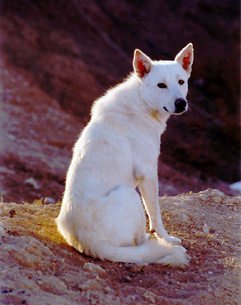The Cnaan dog

Israel’s Native Dogs
Since time immemorial,
the Bedouins have used this dog for guarding their herds and camps. At
the time of the Diaspora, the Israelites were forcefully removed from
their land and according to tradition had to leave behind their dogs
which reverted to the wild. Excavations in Israel unearthed the Ashkelon
dog cemetery, the largest known animal cemetery in the ancient world,
containing 700 dog skeletons, all of which were anatomically similar to
the Canaan dog of modern times. The cemetery dates back to the time of
occupation by the Persian Empire and archaeologists hypothesize that the
dogs were revered as sacred animals. Dr. Rudolphina Menzel (1891–1973)
used these intelligent scavenger-dogs mainly found in the desert as
guard dogs. In the 1930s, Menzel was asked by the Haganah to build up a
service dog organization. She captured a select group of semi-wild
individuals, tamed, trained and bred them. Menzel found the dogs highly
adaptable, trainable, and easy to domesticate. It took her about six
months to capture her first dog, Dugma, and within a few weeks she was
able to take him into town and on buses. She began a breeding program in
1934, providing working dogs for the military and she gave pups to be
pets and home guard dogs. She initiated a selective breeding program to
produce the breed known today as the Canaan dog.
 In 1949, Menzel founded
The Institute for Orientation and Mobility of the Blind, and in 1953,
she started to train Canaan dogs as guide dogs for the blind. Although
she was able to train several dogs, she found that the breed was too
independent and too small for general guide dog use, although some of
her dogs were used successfully by children. Her breeding program was
concentrated with the Institute, where a foundation of kennel-raised
Canaan dogs was established, carrying the name "B'nei Habitachon". In
addition, a controlled collection of dogs of the original type was
continued, primarily from the Bedouin of the Negev. She later supplied
breeding stock to Shaar Hagai Kennels which continued in the breeding of
the Canaan dog. After her death in 1973, Shaar Hagai Kennels, managed by
Dvora Ben Shaul and Myrna Shiboleth, continued the breeding program
according to her instructions.
In 1949, Menzel founded
The Institute for Orientation and Mobility of the Blind, and in 1953,
she started to train Canaan dogs as guide dogs for the blind. Although
she was able to train several dogs, she found that the breed was too
independent and too small for general guide dog use, although some of
her dogs were used successfully by children. Her breeding program was
concentrated with the Institute, where a foundation of kennel-raised
Canaan dogs was established, carrying the name "B'nei Habitachon". In
addition, a controlled collection of dogs of the original type was
continued, primarily from the Bedouin of the Negev. She later supplied
breeding stock to Shaar Hagai Kennels which continued in the breeding of
the Canaan dog. After her death in 1973, Shaar Hagai Kennels, managed by
Dvora Ben Shaul and Myrna Shiboleth, continued the breeding program
according to her instructions.
Collection of wild Canaan dogs
in Israel has become very difficult, because many of the Canaan dogs
living in the open there were destroyed by the Israeli government in the
fight against rabies. The spread of the human population into areas that
were formerly isolated, along with their pet dogs, has resulted in the
loss of the natural habitat of the Canaan. Even the majority of Bedouin
dogs today, other than those of tribes still living a traditional and
isolated life style, are mixed with other breeds. It is possible that
there are still original Canaans among Bedouin tribes that still live
the traditional nomadic life elsewhere, and perhaps in Egypt. Myrna
Shiboleth visits the Negev regularly, looking for good specimens living
by the Bedouin camps, that she can breed with her dogs and use to
strengthen the gene pool.